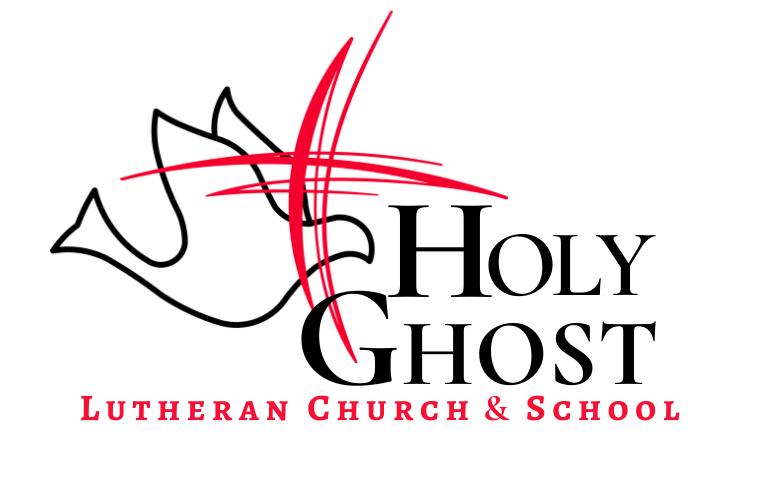4th Grade Curriculum
Holy Ghost Lutheran School’s curriculum integrates Christian faith and Common Core Standards.
Religion–We are using the “One in Christ” Concordia series. It consists of 9 units, including 108 lessons with related Bible verses and catechism for Memory Work. The hymnal “All God’s People Sing” is used in daily worship. The students are taught key concepts of faith, such as Law and Gospel, confession, repentance, forgiveness, and grace, while focusing on the actions of our God on behalf of His people. The course is a chronological study of Bible stories (Creation, the nation Israel, King David and Solomon, and the Exile in the Old Testament and the stories of Christmas, Lent, and Easter, the teachings of Jesus, and the beginning of the Christian Church in the New Testament).
ELA – The English Language Arts (ELA) block is a ninety-minute period Monday-Friday. During this time every student is encouraged to engage in reading and writing by making personal connections to literature in order to become life long readers. A balance literature approach is used in alignment with the Common Core Standards.
The components of the program are a daily spelling series from Zaner Bloser, weekly grammar, vocabulary, decoding, writing and reading using the Journeys reading program. A weekly comprehension homework worksheet will be given on an assigned book, which is at an appropriate reading level for each child. The Raz reading program is used for benchmarking reading levels and for independent computer comprehension reading practice. The students read and write every day in a variety of genres using selected literature that support and reinforce our Christian faith.
Weekly homework is assigned in spelling using a homework chart that explains the assignment for each day. The students are expected to keep daily assignments in a school issued agenda.
The New York State ELA Exam is administered in the spring. It is a two-part standardized test that assesses the students reading and writing skills.
Math– The major topics are: Number Sense and Operations (place value, addition, subtraction, multiplication, division, fractions, decimals, estimation), Algebra (equations=, inequalities<>, numeric and geometric patterns), Geometry (polygons, points, line
segments, angles, 2-dimensional shapes, symmetry, perimeter, area), Measurement (customary and metric, weight, mass, capacity, length, money–making change, elapsed time), and Statistics and Probability (collect and represent data using tables, bar graphs, pictographs, and line graphs, make predictions, form conclusions).
The mastery of multiplication/division facts is expected, with an understanding of the inverse property of the operations, as well as multiplying 2 digits x 1 digit, with and without regrouping. The following concepts are developed: dividing 2 digit dividends by 1 digit divisors with and without remainders; multiplying 2 or 3 digits by 2 digits multiplying and dividing with multiples of 10, 100, and 1000; equivalent fractions, mixed numbers, improper fractions, addition and subtraction of fractions, addition and subtraction of mixed numbers, multiplying fractions with whole numbers, decimals as parts of a whole; reading and writing decimals to hundredths, using money as a context; and the beginnings of algebra—evaluating and expressing relationships using open sentences, with one operation, and finding values to make an open sentence true, if it contains < or>. There is a major focus on reading, understanding, and solving of word problems. Students are expected to be able to explain their work. Manipulatives are used to aid in instruction. The math series by Pearson/Scott Foresman-Addison Wesley and other supplemental materials are also used. www.ixl.com is one of the programs that we use to review and reinforce the concepts being taught. We also use www.xtramath.org to help students improve fluency of basic math facts. A state test is given in the spring.
Social Studies-The students are taught about the state of New York. They learn about its past history and how it changed over time, affected by other cultures and countries. The geography, natural resources, and regions of New York are studied. New York’s government and economics in the past and today are taught. Important vocabulary words will be learned (ex. longhouse, ally, militia, canal). The students also learn about the 50 states, which includes the state capital, the state abbreviation, and its location in the country.
Science– The subject matter is divided into four units: Life Science, Earth Science, Physical Science, and Space and Technology. It is cross-curricular with links to literacy and math. Each chapter has vocabulary words to learn (ex. friction, energy, gravity). Students are also taught about science careers, which relate to the chapter. Each chapter in the book (Scott Foresman Science) has science investigations-some are teacher demonstrated, some individual student hands-on, and some small group hands-on. Our Christian faith is also linked to science as God is taught as the Creator, and He is glorified through the wonder of His creation.
Physical Education–Warm-ups, exercises, and running laps for physical fitness and endurance are done weekly. Games and skill development in sports helps to further develop gross motor skills, students working as part of a team, cooperation, and molding the behavior of good Christian sportsmanship. Sneakers are needed
Test/Homework– Folders are used by the student for ELA, Math, Science, and Social Studies to organize important papers and to record vocabulary word definitions to help in studying and with learning. A study guide will be provided for Social Studies and Science tests at least a week before the test. Math homework is regularly assigned and is due the next school day. Students record their homework assignments in a daily assignment agenda. Memory verse tests are twice a week. Homework should not exceed 40 minutes per night, on average.
